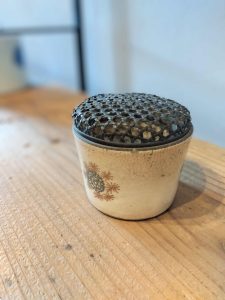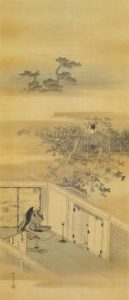「七五三」は縁起の良い数字(愛知県名古屋市千種区姫池通 骨董買取 古美術風光舎)
2024.11.13
皆さまこんにちは、スタッフTでございます。

気持ちがいい秋晴れの日となりました。近くの城山八幡宮からの帰り道でしょうか、着物姿の小さな女の子とその家族に遭遇しました。「あぁ、もうそんな時期かぁ」と七五三を思い出しました。晴れ着を着てはしゃぐ子もいれば、慣れない格好にぐずる子も…。そういえば、私は全部泣き顔の記念写真だったなぁと思い出しました。
諸説ありますが、七五三のルーツはさかのぼること平安時代!宮中で行われていた3つの儀式が基になっているそうです。
現代に比べ、医療が発達していなかった当時は、子どもの死亡率はとても高く「七歳までは神のうち(神の子)」という言葉があったほどだったといいます。そのため宮中や公家では、節目となる歳に子どもの成長を祝い幸福と健康を祈りました。
そういえば七五三は、昔から毎年11月15日に行いますね。暦にも書いてあります。なぜなのかちょっと気になるところですが、どうやら、陰陽道からきているようです。
7・5・3は縁起のいい数と言われ、いずれも奇数で、陰陽の陽にあたるからとされています。たとえば節句のひとつに、旧暦9月9日の重陽(ちょうよう)があります。これは陽が重なる極数であり、とてもおめでたい日とされます。他にも、3月3日は桃の節句、5月5日は端午の節句、7月7日は七夕と、いずれも陽が重なる日になります。
7・5・3を足すと15になり、陽を重ねた日となりますが、その15日のなかでもなぜ11月が選ばれたのかというと、旧暦の11月には、陰陽道の「一陽来復」という縁起の良い月だったためとも言われ、さらに11月15日には、鬼が出歩かない「二十七宿の鬼宿日」であるため、婚礼以外のお祝いをするには吉日であったからともいわれています。
それ以外に、徳川5代将軍綱吉の子徳松の健康祈願の日という説や11月15日に祭りが多いという説などがあるようです。また幼児の髪置(かみおき)・袴着(はかまぎ)・帯解(おびとき)の祝い行事に由来するという江戸時代の、とりわけ武家社会の儀式に根ざしている説もあるといわれています。
縁起の良い数字といわれる「七五三」。そういえば、お正月に準備する「しめなわ」は「七五三縄」と書きます。というのも横に張った縄に7本、5本、3本と藁を束ねて垂らすから。〆縄とか標縄、注連縄という当て字もありますが、「しめなわ」は七・五・三の数字と縁が深いようですね。
七五三の定番といえば「千歳飴」。七五三には欠かせない縁起菓子の千歳飴ですが、江戸時代、東京・浅草の飴屋さんが売り出し、流行したとされています。もともとは千年飴という名前だったそうで、千年という長い期間、つまり長生きを願うとされ、飴自体の形もこれに習って細長い形になっています。ちなみに、千歳飴の長さは最長1メートルまでと決められており、太さも15ミリという制限があるそうです。そんな決まりがあるとは…。
大人になると全く関係ないと思っていた千歳飴ですが、長く健やかにとの願いが込められているなら、祖父母や両親に千歳飴を送ってみるのも悪くないかも。そうしたらきっと驚くだろうな…。
ではでは、また。
Hello everyone, this is Staff T.
It was a beautiful sunny autumn day. On my way home from nearby Shiroyama Hachimangu Shrine, I came across a little girl and her family dressed in kimonos. It reminded me of the Shichi-Go-San Festival. Some of the girls were excited to be dressed in their traditional “Harematsu” (traditional ceremonial kimono), while others were gagging in their unfamiliar outfits. I remembered that I had taken a commemorative photo with a crying face.
There are many theories, but the roots of Shichi-Go-San go back to the Heian period (794-1185)! It is said to be based on three ceremonies held at court.
At that time, when medical care was less developed than it is today, the mortality rate of children was very high, so much so that there was a saying that “children are God’s children until they are seven years old. For this reason, the court and court nobles celebrated the growth of children and prayed for their happiness and health at this milestone age.
Come to think of it, Shichi-Go-San has been held on November 15 every year since ancient times. It is also written in the calendar. I am a little curious as to why, but it seems to come from the Yin-Yang Tao.
Seven, five, and three are said to be auspicious numbers because they are all odd numbers and correspond to the yang of yin and yang. For example, one of the festivals is Chou-you, which falls on September 9 of the lunar calendar. This is a very auspicious day because it is a polar number of overlapping yangs. Other days with overlapping yangs are Peach Festival on March 3, Dragon Boat Festival on May 5, and Tanabata Festival on July 7.
Adding 7, 5, and 3 together makes 15, which is a day that overlaps yang. The reason why November was chosen among these 15 days is said to be because November in the lunar calendar was an auspicious month in the Yin-Yang Tao, “Ichiyo Raicho,” and also because November 15 is the “Onishuku day of 27 inns,” when demons do not walk out, It is also said that November 15 was an auspicious day for celebrations other than weddings. Other theories include that it is a day to pray for the health of Tokumatsu, the son of the 5th Tokugawa Shogun Tsunayoshi, and that there are many festivals on November 15.
There is also a theory that many festivals are held on November 15. There is also a theory that it is rooted in the rituals of the Edo period, especially those of the samurai community, and originates in the celebratory events of kamioki, hakamagi, and obi toki for young children.
Shichi-Go-San” is said to be a lucky number. The “Shime-nawa” prepared for New Year’s is written as “Shichigosan-nawa. The reason for this is that seven, five, and three strands of straw are bundled and hung from a rope stretched horizontally. There are other names for the rope, such as “shime-nawa,” “motenawa,” and “shimenawa,” but “shime-nawa” seems to be closely related to the numbers seven, five, and three.
Chitoseame” is a staple of Shichi-Go-San. Chitose-ame is a good-luck candy that is indispensable for Shichi-Go-San. It is said that it became popular in the Edo period when a candy shop in Asakusa, Tokyo, started selling it. It was originally called “Chitose-ame” (meaning “thousand-year candy”), which is believed to wish for a long period of time, in other words, a long life, and the shape of the candy itself is also based on this belief. Incidentally, the length of Chitose Ame is limited to a maximum of 1 meter, and the thickness is also limited to 15 millimeters. I didn’t know there was such a rule….
I thought Chitose Ame had nothing to do with me as an adult, but if it contains a wish for a long and healthy life, it might not be a bad idea to send Chitose Ame to my grandparents and parents. I am sure they would be surprised…
See you soon.
*******************
ご実家の整理やお片付けなどをされている方のご相談などが多くございます。
お片付けなどくれぐれもご無理のないようになさってくださいませ。
風光舎では古美術品や骨董品の他にも絵画や宝石、趣味のお品など様々なジャンルのものを買受しております。
お片付けをされていて、こういうものでもいいのかしらと迷われているものでも、どうぞお気軽にご相談下さいませ。
また風光舎は、出張買取も強化しております。ご近所はもちろん、愛知県内、岐阜県、三重県その他の県へも出張いたします。
まずは、お電話お待ちしております。
愛知県名古屋市千種区姫池通
骨董 買取【古美術 風光舎 名古屋店】
TEL052(734)8444
10:00-17:00 OPEN
#出張買取#骨董#古美術#骨董品#絵画#版画#茶道具#刀剣#彫刻















